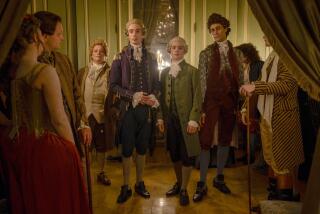‘Devil’ Dresses Detective Story in ‘40s Style and Historical Accuracy
- Share via
In “Devil in a Blue Dress,” Ezekiel (Easy) Rawlins (Denzel Washington), a gutsy charmer turned gumshoe, risks crossing social and racial lines in 1948 Los Angeles to solve two murders before he is blamed for them himself. (Rated R)
*
Surely it is the rare child of the ‘90s who is familiar with the conventions of the hard-boiled detective novel of the ‘40s. The few who came to see “Devil,” which is based on the first of Walter Mosley’s Easy Rawlins novels, got an introduction to the basics:
* The pithy, poetic narrator who gets recruited to find a lost siren in big trouble and big shoulder pads.
* The search that takes him to the mansions of the rich, the low-rent apartments of the working class and the beach.
* The gangsters who ambush him in his office or home.
The narrator doesn’t use a gun but knows people who do. They all smoke and drink a lot at breakfast. The characters also talk a lot in order to explain intricate plot twists. Sexual tension pervades. But there hardly are ever any massive explosions or car chases.
Nima Fatholla, 13, of Anaheim, said he’d give “Devil” a “D. It was boring.”
Matt Monahan, 14, of Laguna Beach, who went with his mother and father (“My dad, he’s from the ‘40s,” Matt explained), agreed that the movie wasn’t hard-boiled enough to compete with the “Die Hard” series.
But on the positive side, he observed, “it wasn’t a movie where you fall asleep. I kept trying to figure out what was going to happen next.”
And, Matt said, more than most movies he sees, “Devil” struck him as “nonfiction.” Indeed, history and social science lessons are tucked seamlessly into the story. Parents easily could use this movie to open discussions of historical movements or race relations.
Rawlins, like many World War II veterans from Texas and Louisiana, used the G.I. Bill to move to California in search of a job at a shipyard or aircraft factory. It was a time when cars looked like lima beans; everyone wore hats, and a loaf of bread cost 15 cents.
It also was a time when segregation and prejudice were facts of life, and people crossed “color lines” at their peril. When Rawlins goes to meet missing woman Daphne Monet (Jennifer Beals) at the “white only” Ambassador Hotel, a bellboy must sneak him up to her room. He knows he is “stupid” for driving with her at night through a white neighborhood north of Wilshire.
He also knows that when a murder victim is white, the police will be “playing for keeps.”
Trying to do his job amid the racial land mines, Rawlins perfects his timing, knowing when and how to assert himself to get what he wants.
The murders and violence are only slightly more graphic than they were in the film’s counterparts from the ‘40s. But there is decidedly more heavy breathing and adult language.
None of which shocked the “Die Hard” veteran. Said Matt: “I didn’t think it was that bad.”
More to Read
Only good movies
Get the Indie Focus newsletter, Mark Olsen's weekly guide to the world of cinema.
You may occasionally receive promotional content from the Los Angeles Times.








